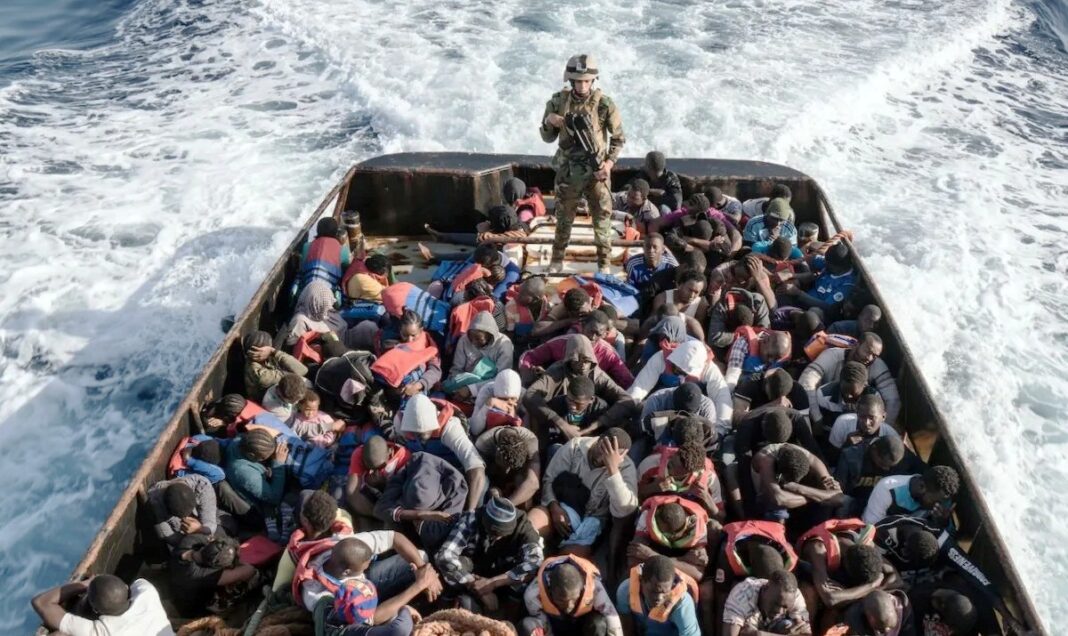Poland’s Prime Minister, Donald Tusk, announced that Poland has introduced temporary border controls with Germany and Lithuania.
“Our decision is irreversible, regardless of the emotions present in other countries,” the Prime Minister emphasized.
Donald Tusk also spoke about returning illegal migrants from Germany:
“I have spoken several times with the German Chancellor and informed him that Poland’s patience on this issue is running out.”
Europe Calls on Libya to Stop the Flow
According to the UN Refugee Agency (UNHCR), in 2021, 32,400 refugees and migrants traveled from Libya to Europe, which is twice as many as in 2020.
EU Commissioner for Migration Magnus Brunner stated that Europe will take a “strict” stance toward the Libyan authorities due to the increase in illegal migration across the Mediterranean Sea.
“This is an issue that concerns us greatly. I believe we need to be swift and resolute,” he said.
Greece recently announced the deployment of military vessels to the region’s international waters, following a sharp increase in crossings from Libya to the Greek island of Crete.
Libya is the main departure point for maritime routes toward Europe, and serious human rights violations against refugees and migrants there — including torture — have been widely documented.
In April, European Commission President Ursula von der Leyen proposed increasing the number of EU external border and coast guard personnel by 30,000, which would significantly improve the effectiveness of protecting Europe’s external borders.
Mediterranean States Oppose the Franco-British Plan
Five European Mediterranean states have criticized the draft migration agreement between France and the United Kingdom. Italy, Spain, Greece, Malta, and Cyprus have filed a written complaint about this with the European Commission.
What are the terms of the deal?
The governments of Britain and France are considering a migrant exchange scheme based on the principle of “one in, one out.”
Under the plan, the United Kingdom would return illegal migrants to France in exchange for individuals who seek asylum under family reunification programs.
The partnership aims to ease pressure on the UK’s asylum system, while simultaneously giving France a legal basis to return migrants.
However, there are fears and assumptions that most of those rejected by Britain would be sent to Southern Europe, since under European law, asylum seekers must apply for asylum in the first EU country they enter.
And in most cases, the country of entry to the old continent ends up being one of the “Mediterranean Five.”
Human Rights or National Interests
In May, the Danish government, together with its Italian counterparts, filed an appeal requesting an assessment of whether the European Court of Human Rights (ECHR) is interpreting the European Convention on Human Rights correctly.
Seven more countries signed the document. They argue that the European Court of Human Rights has shifted the “balance” in favor of migrants, thereby undermining the national interests of states.
The signatories have called for simplifying the deportation procedures for migrants who have committed crimes, expanding surveillance capabilities over foreign offenders, and creating stronger enforcement tools.
One of Denmark’s main initiatives will be to promote the idea of establishing “return centers” — special camps outside the European Union where migrants would be placed while their asylum applications are being processed.
Such centers have already been set up in Albania under an agreement with Italy, although the initiative has faced serious legal challenges and strong criticism from human rights advocates. Denmark plans to join Italy in convincing the remaining 25 EU countries that this is the best solution for a Europe struggling with uncontrolled migration.
Which Countries Are Sending Back Illegal Migrants
What do the official statistics show? Which country returns the most illegal migrants?
According to Eurostat data for the third quarter of 2024, Slovakia returned the fewest illegal migrants — 55 people. Next is Slovenia with 80 migrants, followed by Portugal with 85.
France returned nearly 4,000 people, while Germany and Spain expelled slightly more than 3,000 each.
In the first quarter of 2025, according to Eurostat, the largest number of illegal migrants were again returned from France, Germany, and also Cyprus. Luxembourg, Slovenia, and Slovakia expelled the fewest migrants.
The data indicates that the European Union, overall, is increasing efforts to contain illegal migration.
According to data from the UK government, between March 2024 and March of this year, 44,125 illegal crossings of the English Channel were recorded — a 14% increase compared to the same period in previous years. According to the Migration Observatory at the University of Oxford, approximately 14,800 small-boat crossings were registered between January and May 2025, the highest number ever recorded.
According to Frontex, the number of illegal migration routes in the central and western Mediterranean, heading toward Italy and Spain, increased in the first months of 2025 compared to the previous year (by 7% and 6%, respectively). In Greece, however, illegal border crossings along the eastern Mediterranean route sharply decreased — by 30%.
According to the latest Eurostat data, in 2023 France ranked second in the EU for the number of relocation requests submitted by asylum seekers to other EU member states — 48,724 cases. Meanwhile, Italy received the highest number of illegal migrants relocated from other EU countries.

